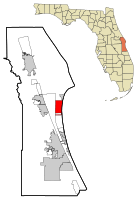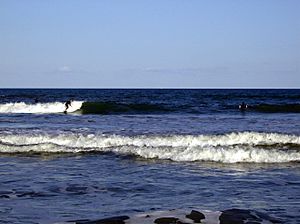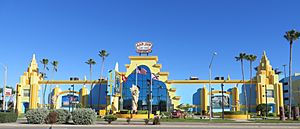Cocoa Beach, Florida facts for kids
Quick facts for kids
Cocoa Beach, Florida
|
|
|---|---|
| City of Cocoa Beach | |

Cocoa Beach
|
|
| Motto(s):
"Open for Business!"
|
|

Location in Brevard County and the state of Florida
|
|
| Country | |
| State | |
| County | |
| Area | |
| • Total | 15.19 sq mi (39.34 km2) |
| • Land | 4.66 sq mi (12.06 km2) |
| • Water | 10.53 sq mi (27.28 km2) |
| Elevation | 10 ft (3 m) |
| Population
(2020)
|
|
| • Total | 11,354 |
| • Density | 2,437.53/sq mi (941.07/km2) |
| Time zone | UTC−5 (Eastern (EST)) |
| • Summer (DST) | UTC−4 (EDT) |
| FIPS code | 12-33450 |
| GNIS feature ID | 0284502 |
Cocoa Beach is a city in Brevard County, Florida, United States. The population was 11,539 at the 2018 United States Census. It is part of the Palm Bay-Melbourne-Titusville, Florida Metropolitan Statistical Area.
Contents
History
The first non-native settlement in the area was by a family of freed slaves following the American Civil War. In 1888, a group of men from Cocoa bought the entire tract of land, which went undeveloped until it was bought out in 1923 by a member of the group—Gus Edwards, Cocoa's city attorney. At that time, Edwards' total holdings included approximately 600 acres (240 ha), and he had stopped practicing law to devote all his efforts to developing the area.
Prior to incorporation, the area was known as Oceanus. The Town of Cocoa Beach was established on June 5, 1925. Cocoa Beach's first official meeting was held at the Cocoa Beach Casino on July 27, 1925, and adopted the City Seal. Gus C. Edwards was elected as mayor and served as a commissioner along with J.A. Haisten, and R.Z. Grabel. A little less than a month later, plans for a pier became official.
In 1935, the FDOT opened up what is now State Road A1A as a one-lane dirt road to Eau Gallie. In 1938, a Deputy Marshal was appointed "to act in emergencies at night or at other times" for $.25/hour. By 1939, the town had 49 residents. In 1940, the town requested that State Road 140 (now A1A) be routed on Orlando Avenue instead of Atlantic Avenue. In 1942, the town prepared to receive men assigned to the newly opened Naval Air Station Banana River. Establishing regular garbage collection was discussed when the town discovered that the Air Station was having theirs collected.
On May 1, 1942, the German submarine U-109 torpedoed the La Paz off the shore of Cocoa Beach. The crew was able to beach it with the help of tugs. Eventually it was returned to shipping. On May 3, the same U-boat sank the SS Laertes near the same spot. Local boys were recruited for salvaging efforts and to rid the beach of subsequent debris. Shortly thereafter, the federal government realized the danger of back-lighting from the coast making easy targets of passing ships and ordered a blackout for the remainder of the war.
During World War II, Cocoa Beach experienced money shortages for employees, and money to fix roads.
In 1944, the town successfully fought a bill introduced in the Florida legislature which would have dissolved the city government. In 1947 a single police officer was hired for $1/hour. The same year, the city constructed works for the distribution of potable water. In 1950, a volunteer fire department was created which used a second-hand vehicle. In 1950, a proposal to prevent people from driving on the beach was defeated. In 1951, the city sought to place a stoplight, the city's first, at the intersection of what is now A1A and Minutemen Causeway. In 1953, the city decided to mark the names of all streets. In 1953, the city planned to pave A1A south from 520 down Orlando Avenue. The city intended to bear 1/3 of the costs, the adjacent property owners, 2/3. In 1954, the Women's Club opened a library in the building used by the Fire Department. In 1955, the speed limit in most of the town was raised to 35 miles per hour (56 km/h). In 1955, the city prepared to house the people who were going to be launching missiles from what is now Cape Canaveral Air Force Station. In 1956, the city attorney warned the council that blacks might attempt to use the beach. If they did, he recommended clearing the beach of all persons, both white and black. The 1954 decision, Brown v. Board of Education, had, in theory at least, integrated all general public facilities. Actual integration came later.
The city proposed selling the town dump to the school board for a junior high school, in order to keep students from being bused to Merritt Island.
On June 29, 1957, the town of Cocoa Beach incorporated into a city. In September 1959, the city voted to add more sidewalks, improve the streets in residential areas as well as the main streets, and to pave more roads.
In 1965, Cocoa Beach High School requested that Cocoa Avenue, the street that the school was located on, be renamed Minutemen Boulevard, in honor of the school's mascot, the Minuteman.
Cocoa Beach started its major growth during the 1960s.1000% population increase from 1950 to 1960) as a result of America's space program. NASA's John F. Kennedy Space Center is located approximately 15 miles (24 km) north of town. Many people moved to Cocoa Beach due to jobs connected to the space program and in search of new opportunities.
After manned space flights, the town held parades in honor of the astronauts.
After NASA's Apollo program came to an end, and before the Space Shuttle program was in full swing, the town's economy reflected the resulting layoffs. At one point, in 1975, unemployment was 14.3%. Many families lost their jobs or simply moved away. The housing market plummeted and some people unable to sell their homes simply abandoned them.
Cocoa Beach was the setting for the 1960s sitcom I Dream of Jeannie, although no episodes were actually filmed there, and star Barbara Eden only made two visits during the show's production — both in 1969, for publicity. Cocoa Beach High School was used as the school in the 2002 movie Race to Space.
The 2010 Nebula Awards were held in the city.
In 2016, the largest mansion in the city was destroyed by fire. It had been built on the beach by Al Neuharth in 1975. It contained 10,000 square feet (930 m2) of living space, 11 bedrooms and 12 bathrooms. It was valued at several million dollars.
Geography
According to the United States Census Bureau, the city has a total area of 15.0 square miles (39 km2). 4.9 square miles (13 km2) of it is land and 10.1 square miles (26 km2) of it (67.49%) is water. Bordering the city on the north is Cape Canaveral; on the south is Crescent Beach; on the east is the Atlantic Ocean (5.6 mi or 9.0 km of oceanfront); on the west is the Banana River.
Propelled by a powerful hurricane, the ocean pushed its way through the barrier islands centuries ago and formed the Thousand Islands in the Banana River.
There are a number of boating channels dredged in the area: the 0-99 Channel, the 100 Channel, the 200 Channel for houseboats, the 300 Channel, the 400 Channel near housing for private boats, the 500 Channel and the 600 Channel. Dredged material is placed on one of the Thousand Islands, but is now controlled.
Many of the homes in Cocoa Beach are built on dredged mud and sand from the Banana River.
Surrounding areas
Climate
Cocoa Beach's has a humid Subtropical Climate Köppen climate classification of Cfa. This climate features hot and humid summers with frequent tropical downpours and daily thundershowers, and warm, dry, and sunny winters. The average high temperature in the warmest month (July) in Cocoa Beach is 91 °F (33 °C) and the average high in the coolest month (January) is 72 °F (22 °C).
| Monthly Normal and Record High and Low Temperatures | ||||||||||||
| Month | Jan | Feb | Mar | Apr | May | Jun | Jul | Aug | Sep | Oct | Nov | Dec |
|---|---|---|---|---|---|---|---|---|---|---|---|---|
| Rec High °F | 89 | 92 | 93 | 97 | 97 | 101 | 102 | 101 | 98 | 96 | 91 | 89 |
| Norm High °F | 72 | 73 | 77 | 81 | 85 | 89 | 91 | 90 | 88 | 83 | 78 | 73 |
| Norm Low °F | 50 | 51 | 55 | 60 | 66 | 71 | 72 | 73 | 72 | 67 | 60 | 53 |
| Rec Low °F | 17 | 27 | 25 | 35 | 47 | 55 | 60 | 60 | 58 | 41 | 30 | 21 |
| Precip (in) | 2.48 | 2.49 | 2.92 | 2.08 | 3.94 | 5.83 | 5.38 | 5.78 | 7.20 | 4.76 | 3.12 | 2.31 |
| Source: The Weather Channel | ||||||||||||
Demographics
| Historical population | |||
|---|---|---|---|
| Census | Pop. | %± | |
| 1930 | 31 | — | |
| 1940 | 49 | 58.1% | |
| 1950 | 246 | 402.0% | |
| 1960 | 3,475 | 1,312.6% | |
| 1970 | 9,952 | 186.4% | |
| 1980 | 10,926 | 9.8% | |
| 1990 | 12,123 | 11.0% | |
| 2000 | 12,482 | 3.0% | |
| 2010 | 11,231 | −10.0% | |
| 2020 | 11,354 | 1.1% | |
| U.S. Decennial Census | |||
As of the census of 2010, there were 11,231 people, while estimated population as per 2017 is 11733 6,529 households, and 3,532 families residing in the city. The population density was 2,552.1 inhabitants per square mile (985.5 per km2). There were 8,709 housing units at an average density of 1,780.6 per square mile (687.6 per km2). The racial makeup of the city was 96.64% White, 0.62% Black, 0.22% Native American, 1.07% Asian, 0.06% Pacific Islander, 0.30% from other races, and 1.08% from two or more races. Hispanic or Latino of any race were 2.52% of the population.
There were 6,529 households, 12.9% of which had children under the age of 18 residing; 45.5% were married couples living together; 5.8% had a female householder with no husband present, and 45.9% were non-families. 38.3% of all households were made up of individuals, and 18.7% were households of persons 65 years of age or older living alone. The average household size was 1.91 and the average family size was 2.47.
The city's population was divided into the following age groups: 12.2% under the age of 18; 3.8% between 18 and 24; 22.0% between 25 and 44,; 27.6% between 45 and 64, and 34.4% who were 65 years of age or older. The median age was 54 years. For every 100 females, there were 99.3 males. For every 100 females aged 18 years and older, there were 96.4 males.
Cocoa Beach is a retirement area, with an average age of 56.5.
Landmarks
- Cocoa Beach Pier
- Alan Shepard Beachfront Park
- Thousand Islands Conservation Area
- Cocoa Beach Aquatic Center and Pool Complex
- I Dream of Jeannie Lane
Former
- In 1960, a structure on A1A was built that contained a branch of the First Federal Bank of Florida. It was glass and stood on spindly legs. Despite a major overhaul in 1981 that covered much of the glass structure in concrete, it was still called the "Glass Bank" by locals. It was damaged by Hurricane Frances, and was later demolished in early 2015.
Sister cities
 Kyustendil, Bulgaria
Kyustendil, Bulgaria
Economy
Personal income
According to the census, the median income for a single household in the city was $42,372, and the median income for a family was $51,795. Males had a median income of $39,418 versus $27,113 for females. The per capita income for the city was $28,968. About 3.7% of families and 6.5% of the population were below the poverty line, including 9.8% of those under age 18 and 4.0% of those age 65 or over.
Tourism
Ron Jon's, a surf shop, receives 2 million visitors a year. Cocoa Beach is home to the East Coast Surfing Hall of Fame.
The Cocoa Beach Pier, formerly known as the Cape Canaveral Pier, was built in 1962. An annual Easter Surfing Festival began in 1964. An estimated 100,000 spectators attend annually.
An air show in 2009 drew a crowd estimated at 30,000.
The Ron Jon Easter Surfing Festival drew 50,000 visitors in 2009, while around 10,000 visitors attend the Surfing Santas festival each year at Christmas.
The largest charity surfing festival, National Kidney Foundation Pro-Am Surfing Festival, has been held every Labor Day Weekend in Cocoa Beach since 1985.
In 2015 businesses in the city collected $5.6 million in tourist tax, over half the tourist tax collected in the county and more than any other municipality, $1.4 million.
Workforce
In 2007, Cocoa Beach's median labor force was 6,344. Of that group, 6,006 were employed and 338 were unemployed, for an unemployment rate of 5.3%.
Housing
In 2008, 6 building permits were issued. This was down from 9 permits for 11 units in 2007, which was down from 20 permits for 34 units in 2006.
The median home price in 2007 was $409,000.
Language
The primary language spoken in Cocoa Beach is English, with 9.8% of the population speaking languages other than English at home.
Travel Time to Work
Mean travel time to the work is 25.4 minutes from home to work.
Education
The city has three public schools:
- Freedom 7 Elementary
- Theodore Roosevelt Elementary
- Cocoa Beach High School
Freedom 7 Elementary school and Cocoa Beach Jr./Sr High School both are certified International Baccalaureate schools. Freedom 7 Elementary has a primary years program, and Cocoa Beach Jr./Sr High has both a middle years program and a diploma program.
96.1% of all residents 25 years or older are high school graduates. 42.3% have a Bachelor's Degree or higher.
Infrastructure
Roads
The following roads are usually called by their numbers when spoken:
 SR A1A – This is the main road through the city. From north to south, SR A1A enters Cocoa Beach from Cape Canaveral as Atlantic Avenue. After passing the downtown area and resort area, the road splits into a one-way pair of roads, southbound being named Orlando Avenue, with northbound keeping the name Atlantic Avenue. The route continues in this manner until the southbound town limits. Major intersections include SR 520, 4th Street, and Minutemen Causeway.
SR A1A – This is the main road through the city. From north to south, SR A1A enters Cocoa Beach from Cape Canaveral as Atlantic Avenue. After passing the downtown area and resort area, the road splits into a one-way pair of roads, southbound being named Orlando Avenue, with northbound keeping the name Atlantic Avenue. The route continues in this manner until the southbound town limits. Major intersections include SR 520, 4th Street, and Minutemen Causeway. SR 520 – This is the main way to access the city from the mainland. It enters the city from the unincorporated community of Merritt Island, and the route terminates at SR A1A. Major intersections include the Cape Canaveral Hospital entrance, Banana River Boulevard, and SR A1A.
SR 520 – This is the main way to access the city from the mainland. It enters the city from the unincorporated community of Merritt Island, and the route terminates at SR A1A. Major intersections include the Cape Canaveral Hospital entrance, Banana River Boulevard, and SR A1A.
It is estimated that there are 2.4 million day trippers to the city annually. While businesses appreciate the tourism, it creates a parking problem for the city. There are 1,780 paved parking spaces and 607 spaces on the streets downtown, near the beach.
Public transportation
Public transportation in Cocoa Beach, Cape Canaveral, and surrounding Brevard County is provided by Space Coast Area Transit.
Utilities
The city contracted directly with Florida Power & Light for electricity, paying 10.689 cents per kilowatt hour in 2010.
Canals
The city has 37 canals, totaling 9 miles (14 km), serving residential homes, plus 17 miles (27 km) of channels. These are maintained by the city.
Notable people
- Kim Adler, professional bowler and USBC Hall of Famer, 5th Street
- Allison Anders, raised in the city. Filmed Things Behind the Sun in the county in 2001
- Willam Belli, a drag queen, actor, recording artist, and YouTuber raised in the city
- Dana Brown, iconic surfing legend, 16th Street
- Cullen Douglas, television and movie actor, director, screenwriter
- James Folston professional football player for the Oakland Raiders #55
- Ashlyn Harris, professional soccer player
- Jay F. Honeycutt, former director of the Kennedy Space Center
- Zora Neale Hurston, author
- Rick Martel, former professional wrestler
- Bubba McDowell, professional football player with the Houston Oilers #25
- Allen Neuharth, CEO of Gannett and columnist. Founder of USA Today
- Kelly Slater, professional surfer, 11-time World Champion
- George Steele, professional wrestler a.k.a. George "The Animal" Steele
- Carrot Top, comedian, actor, was born in the city
- Lori Wilson, Florida state legislator and lawyer
- Melissa Witek, Miss Florida USA 2005 and contestant on NBC's Treasure Hunters
- Nancy Yasecko, filmmaker and videographer
See also
 In Spanish: Cocoa Beach para niños
In Spanish: Cocoa Beach para niños





